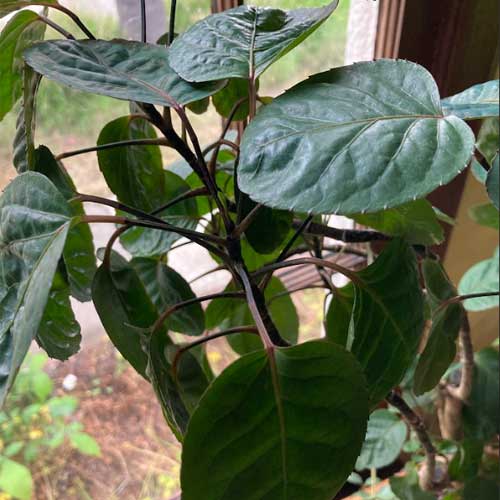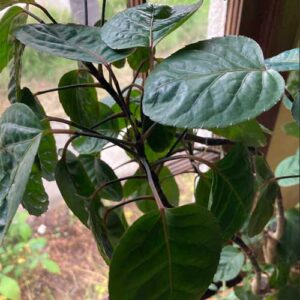About Ming Aralia

Ming Aralia Introduction
Ming Aralia (Polyscias fruticosa) is an elegant evergreen shrub known for its intricately divided, feathery foliage that gives it a delicate, lace-like appearance. Native to tropical regions of India and Polynesia, this sophisticated plant can grow up to 6-8 feet tall indoors and even taller in its natural habitat.
The plant’s most distinctive feature is its finely divided, compound leaves that are dark green and glossy, creating a dense, fernlike canopy. Each leaf is comprised of many small leaflets arranged in a complex pattern, giving the plant its unique, architectural appearance. The stems are woody and typically grow in an upright fashion, though they can be trained and pruned to create different shapes.
Ming Aralia is particularly valued for its versatility in interior design, often used in both traditional and modern settings. While it rarely flowers indoors, its primary appeal lies in its sculptural form and intricate foliage pattern. The plant’s growth pattern is relatively slow, making it manageable for indoor cultivation, though it requires specific conditions to thrive.
Ming Aralia Care & Growing Guide
Caring for Ming Aralia requires attention to detail and consistency, as this tropical plant has specific environmental needs to maintain its distinctive appearance. Understanding its natural habitat helps in creating optimal growing conditions, particularly regarding humidity and temperature requirements.
The key to success with Ming Aralia lies in maintaining proper moisture levels without overwatering, providing bright indirect light, and ensuring adequate humidity. Regular pruning helps maintain its desired shape and promotes bushier growth, while consistent fertilization during the growing season supports healthy development.
While Ming Aralia can be somewhat challenging for beginners, it rewards careful attention with its stunning architectural presence. The plant may take time to adjust to new environments, so patience is essential when first establishing it in your space. Regular monitoring for pests and maintaining stable growing conditions will help ensure the plant thrives in your care.
 Soil
Soil
Ming Aralia requires well-draining, rich potting soil with a pH between 6.0 and 7.0. The ideal soil mixture should contain equal parts potting soil, peat moss, and perlite or sand to ensure proper drainage while retaining adequate moisture.
Soil problems to watch for:
– Poor drainage: Can lead to root rot and leaf drop
– Compaction: Restricts root growth and nutrient uptake
– Inappropriate pH: Affects nutrient availability
– Salt build-up: Results from hard water or over-fertilization
– Nutrient deficiencies: Can cause yellowing leaves and stunted growth
– Root boundness: Requires timely repotting to prevent growth restriction
 Fertilizer
Fertilizer
Feed every 2-3 weeks during growing season with balanced, water-soluble fertilizer (10-10-10). Reduce feeding in winter.
Over-fertilization signs:
– Leaf burn
– Salt crust on soil
– Rapid but weak growth
Under-fertilization signs:
– Pale leaves
– Slow growth
– Smaller leaves
 Watering
Watering
Water when the top inch of soil feels dry, maintaining consistent moisture without waterlogging. Ming Aralia prefers slightly moist soil but is sensitive to overwatering.
Overwatering signs:
– Yellowing leaves
– Leaf drop
– Root rot
– Mushy stems
Underwatering signs:
– Crispy leaf edges
– Drooping foliage
– Slow growth
– Leaf curl
 Lighting
Lighting
Ming Aralia thrives in bright, indirect light. Direct sunlight can scorch its delicate leaves, while insufficient light leads to leggy growth and leaf drop.
Signs of inadequate light:
– Elongated stems
– Pale leaves
– Reduced growth rate
– Leaf drop
Signs of excessive light:
– Burned or bleached leaves
– Crispy leaf edges
– Wilting despite proper watering
 Temperature
Temperature
Optimal temperature range is 65-85°F (18-29°C). Ming Aralia is sensitive to cold and should be protected from drafts and temperatures below 60°F (16°C).
Temperature considerations:
– Avoid cold drafts from windows and doors
– Keep away from heating/cooling vents
– Protect from sudden temperature changes
– Move away from cold windows in winter
 Humidity
Humidity
Ming Aralia prefers humidity levels between 50-70%. Higher humidity levels support optimal growth and prevent leaf problems.
Methods to increase humidity:
– Regular misting
– Humidity trays
– Room humidifiers
– Grouping plants together
Low humidity symptoms:
– Leaf edge browning
– Leaf drop
– Stunted growth
 Propagation
Propagation
1. Stem cuttings (Most successful method):
– Take 4-6 inch cuttings in spring
– Remove lower leaves
– Dip in rooting hormone
– Plant in moist propagation mix
– Maintain high humidity
– Roots develop in 4-8 weeks
2. Air layering:
– Select healthy branch
– Make small wound
– Apply rooting hormone
– Wrap with moist sphagnum moss
– Cover with plastic
– Roots form in 8-12 weeks
 Potting
Potting
Use well-draining pots with drainage holes. Repot every 2-3 years or when roots become crowded.
Repotting signs:
– Roots growing through drainage holes
– Slowed growth
– Water running straight through
– Pot feels light when lifted
 Pruning
Pruning
Pruning Guide for Ming Aralia
Timing and Frequency
– Best done in spring or early summer
– Prune as needed for shape maintenance
Step-by-Step Guide
1. Sterilize pruning tools
2. Remove dead or yellowing leaves
3. Cut back leggy stems
4. Shape the plant as desired
5. Clean up debris
Aftercare
– Reduce watering slightly
– Monitor for new growth
– Resume normal care after 2 weeks
 Blooming
Blooming
Ming Aralia rarely flowers indoors. In its natural habitat, it may produce small, inconspicuous flowers in clusters during warm seasons, but these are not significant for ornamental purposes.
 Pests and Diseases
Pests and Diseases
pests
common_issues
Spider mites
Scale insects
Mealybugs
symptoms: Webbing, yellowing leaves, sticky residue, visible insects
treatment: Insecticidal soap, neem oil, systematic inspection
diseases
common_issues
Root rot
Leaf spot
Bacterial blight
symptoms: Wilting, spots on leaves, yellowing
treatment: Improve air circulation, adjust watering, fungicide application
 Special Features
Special Features
Ming Aralia is prized for its architectural value and finely divided, feathery foliage that creates a dramatic, sculptural appearance. The plants ability to be shaped through pruning makes it popular in bonsai cultivation, while its elegant form adds sophistication to any indoor space.
 Plant Benefits
Plant Benefits
While not commonly used medicinally, Ming Aralia has been traditionally used in some Asian cultures for its potential anti-inflammatory properties. The plant is primarily valued for its ornamental qualities and air-purifying abilities.
 Additional Information
Additional Information
Ming Aralia is often used in traditional Asian gardens and has gained popularity in modern interior design. The plant’s name “Ming” refers to its resemblance to Chinese Ming dynasty art motifs.
 Life Cycle
Life Cycle
Ming Aralia is a slow-growing evergreen that can live for many years with proper care. Growth is most active during spring and summer, with a natural slowdown during winter months. The plant maintains its foliage year-round but may shed older leaves as new growth develops.
 Are Ming Aralia Poisonous, Toxic
Are Ming Aralia Poisonous, Toxic
Ming Aralia is generally considered non-toxic to cats, dogs, and humans. However, as with any plant, ingestion may cause mild gastrointestinal upset in sensitive individuals.
Preventive measures:
– Keep out of reach of curious pets
– Monitor children around plants
– Wash hands after handling
 Frequently Asked Questions
Frequently Asked Questions
Is Ming Aralia toxic to pets?
No, Ming Aralia is generally considered non-toxic to pets, though ingestion may cause mild stomach upset.
How often should I water Ming Aralia?
Water when the top inch of soil feels dry, typically every 5-7 days, adjusting based on environmental conditions.
How tall does Ming Aralia grow?
Indoors, Ming Aralia typically grows 6-8 feet tall, but can be maintained smaller through pruning.
What kind of light does Ming Aralia need?
Ming Aralia needs bright, indirect light. Direct sunlight can damage its delicate leaves.
How do you propagate Ming Aralia?
Ming Aralia can be propagated through stem cuttings or air layering, with stem cuttings being the most successful method.
Why are my Ming Aralia leaves dropping?
Leaf drop can be caused by improper watering, low humidity, temperature stress, or pest problems.
How often should I fertilize Ming Aralia?
Fertilize every 2-3 weeks during the growing season with a balanced fertilizer, reducing in winter.
Does Ming Aralia need high humidity?
Yes, Ming Aralia prefers humidity levels between 50-70% for optimal growth.
How often should Ming Aralia be pruned?
Prune as needed for shape maintenance, typically in spring or early summer.
What temperature does Ming Aralia prefer?
Ming Aralia prefers temperatures between 65-85°F (18-29°C) and should be protected from cold drafts.
 Can I grow Ming Aralia in my indoor space
Can I grow Ming Aralia in my indoor space
Difficulty
Size
Light
Water
Flowering
Pet Safe
Air Purifier
 Polyscias fruticosa botanical details
Polyscias fruticosa botanical details
Common Name
Other Common Names
Botanical Name
Native Area
Family Name
Plant Type
Genus
Kingdom
 Photo Gallery
Photo Gallery
- Perky Plant fertilizer: https://amzn.to/3RdLA00
- Seaweed extract: https://amzn.to/3z2CsFh
- Rooting hormone: https://amzn.to/3bIXi0t
- Espoma fertilizer: https://amzn.to/3vPa9bs
- Worm compost: https://amzn.to/3HVL01u
- Full-spectrum Light Bulb-Large: https://amzn.to/3yR6VBu
- Full-spectrum Lighting: https://amzn.to/3qhhaiv
- Light meter: https://amzn.to/4dpmp3s
- Moisture meter: https://amzn.to/3TEUu5N
- Hygrometer: https://amzn.to/3Cf6h2F
- Pruning shears: https://amzn.to/3X6oOcg
- ProMix Potting Soil: https://amzn.to/3iVIrjE
- My Organic Green Gourmet Houseplant Fertilizer: healthyhouseplants.storenvy.com
- My Perfect Pumice: Healthy Houseplants Store
- My Organic Green Gourmet Houseplant Fertilizer: Healthy Houseplants Store
As an Amazon Associate, I earn commission from qualifying purchases.
 Plant Puns and Jokes
Plant Puns and Jokes
Why did the Ming Aralia become a sculptor? Because it was naturally good at creating fine art with its leaves!




 My Ming Aralia Plant Care Recommendations
My Ming Aralia Plant Care Recommendations Buy Ming Aralia Online
Buy Ming Aralia Online